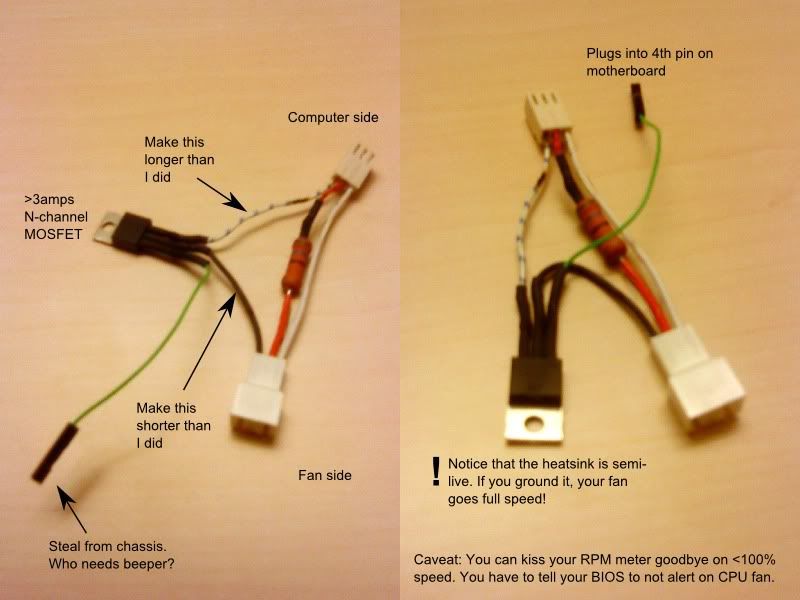Associate
- Joined
- 24 Aug 2012
- Posts
- 11
Note that this is absolutely as KISS as it gets. Particularily, you can kiss your RPM readings goodbye on anything other than 100% speed.
If you want better, Tealc's http://forums.overclockers.co.uk/showthread.php?t=18421145 is for you.
Note to future readers with 3pin fans & 4pin headers: Before you do anything else, check if your BIOS has a setting for 3pin/4pin control. If it does, you can probably just set it to 3pin and stop reading now.

Things you need
My version drives my Zalman 9700 CPU fan from 40% PWM up to 100%, resulting in about half of max speed due to the resistor. The action sounds sort of linear-ish, which probably means it isn't. (Sound level increases exponentially with RPMs)
If you like, you can short out the resistor entirely for full range action. Be aware however that your fans will start spinning at 10-15% PWM and that the curve becomes very aggressive. You'll be going fairly high on RPMs at 60% already. This means that standard BIOS fan controls will likely drive high RPMs throughout, so you might want to be able to tune the PWM curve yourself (via e.g. SpeedFan)... unless you simply want high RPMs, of course.
About the RPM monitoring: no, there is no way to get working RPM monitoring with this few components, you can forget it. With 3 (and switching the MOSFET for a P-channel in high-side driver configuration) you might be able to get it working. But don't take my word for it. Perhaps with a 10-100uF capacitor parallel with the fan? Unknown & untested. One definite caveat is that the heatsink goes +12V live.
Caveats:
Wins:
If you want better, Tealc's http://forums.overclockers.co.uk/showthread.php?t=18421145 is for you.
Note to future readers with 3pin fans & 4pin headers: Before you do anything else, check if your BIOS has a setting for 3pin/4pin control. If it does, you can probably just set it to 3pin and stop reading now.

Things you need
- A resistor package suitable for your fan, Zalman's package should handle most everything with its beefy 56 ohm resistor (7v operation)
- A nice big N-channel MOSFET. 3 amps or bigger and you don't need extra cooling. Minimum 20V throughput. The max Gate voltage can be between 6--20 volts, but don't go bigger than that or the 5V PWM pin feed becomes too low to open the MOSFET properly.
My TV repair shop gave me an IRF630 which is complete overkill. I like it.
Absolutely best is if you can get one rated as logic level input (but still drives plenty of amps) - Steal one connector from your PC chassis.
My version drives my Zalman 9700 CPU fan from 40% PWM up to 100%, resulting in about half of max speed due to the resistor. The action sounds sort of linear-ish, which probably means it isn't. (Sound level increases exponentially with RPMs)
If you like, you can short out the resistor entirely for full range action. Be aware however that your fans will start spinning at 10-15% PWM and that the curve becomes very aggressive. You'll be going fairly high on RPMs at 60% already. This means that standard BIOS fan controls will likely drive high RPMs throughout, so you might want to be able to tune the PWM curve yourself (via e.g. SpeedFan)... unless you simply want high RPMs, of course.
About the RPM monitoring: no, there is no way to get working RPM monitoring with this few components, you can forget it. With 3 (and switching the MOSFET for a P-channel in high-side driver configuration) you might be able to get it working. But don't take my word for it. Perhaps with a 10-100uF capacitor parallel with the fan? Unknown & untested. One definite caveat is that the heatsink goes +12V live.
Caveats:
- Your BIOS will likely "F1 to continue" you in the face with this adapter on the CPU fan because it can't see RPM readings. Disable the monitoring in the BIOS!
- Tools like ASUS Fan Xpert will probably hate you too for the same reason. SpeedFan works!
Wins:
- You can actually turn your CPU fan completely off!
Last edited:



